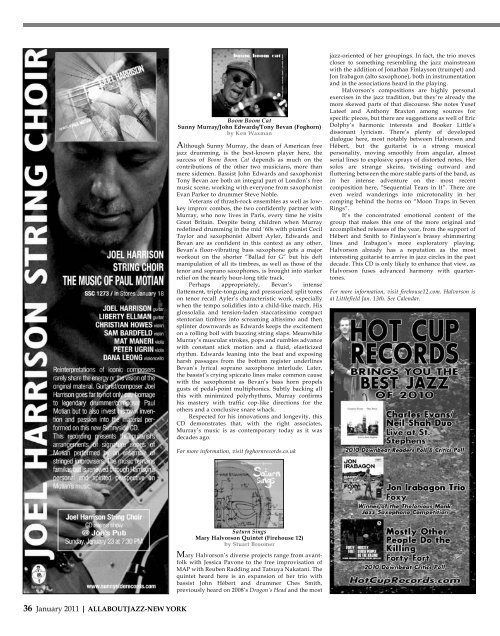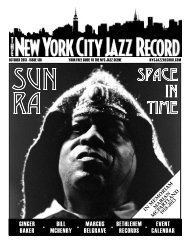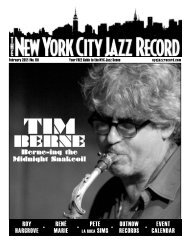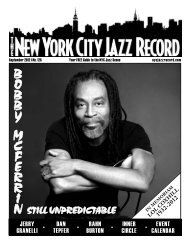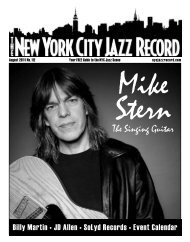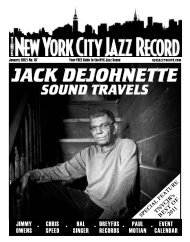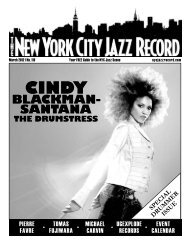heart of gold - The New York City Jazz Record
heart of gold - The New York City Jazz Record
heart of gold - The New York City Jazz Record
You also want an ePaper? Increase the reach of your titles
YUMPU automatically turns print PDFs into web optimized ePapers that Google loves.
36 January 2011 | ALLABOUTJAZZ-NEW YORK<br />
Boom Boom Cat<br />
Sunny Murray/John Edwards/Tony Bevan (Foghorn)<br />
by Ken Waxman<br />
Although Sunny Murray, the dean <strong>of</strong> American free<br />
jazz drumming, is the best-known player here, the<br />
success <strong>of</strong> Boom Boom Cat depends as much on the<br />
contributions <strong>of</strong> the other two musicians, more than<br />
mere sidemen. Bassist John Edwards and saxophonist<br />
Tony Bevan are both an integral part <strong>of</strong> London’s free<br />
music scene, working with everyone from saxophonist<br />
Evan Parker to drummer Steve Noble.<br />
Veterans <strong>of</strong> thrash-rock ensembles as well as lowkey<br />
improv combos, the two confidently partner with<br />
Murray, who now lives in Paris, every time he visits<br />
Great Britain. Despite being children when Murray<br />
redefined drumming in the mid ‘60s with pianist Cecil<br />
Taylor and saxophonist Albert Ayler, Edwards and<br />
Bevan are as confident in this context as any other.<br />
Bevan’s floor-vibrating bass saxophone gets a major<br />
workout on the shorter “Ballad for G” but his deft<br />
manipulation <strong>of</strong> all its timbres, as well as those <strong>of</strong> the<br />
tenor and soprano saxophones, is brought into starker<br />
relief on the nearly hour-long title track.<br />
Perhaps appropriately, Bevan’s intense<br />
flattement, triple-tonguing and pressurized split tones<br />
on tenor recall Ayler’s characteristic work, especially<br />
when the tempo solidifies into a child-like march. His<br />
glossolalia and tension-laden staccatissimo compact<br />
stentorian timbres into screaming altissimo and then<br />
splinter downwards as Edwards keeps the excitement<br />
on a rolling boil with buzzing string slaps. Meanwhile<br />
Murray’s muscular strokes, pops and rumbles advance<br />
with constant stick motion and a fluid, elasticized<br />
rhythm. Edwards leaning into the beat and exposing<br />
harsh passages from the bottom register underlines<br />
Bevan’s lyrical soprano saxophone interlude. Later,<br />
the bassist’s crying spiccato lines make common cause<br />
with the saxophonist as Bevan’s bass horn propels<br />
gusts <strong>of</strong> pedal-point multiphonics. Subtly backing all<br />
this with minimized polyrhythms, Murray confirms<br />
his mastery with traffic cop-like directions for the<br />
others and a conclusive snare whack.<br />
Respected for his innovations and longevity, this<br />
CD demonstrates that, with the right associates,<br />
Murray’s music is as contemporary today as it was<br />
decades ago.<br />
For more information, visit foghornrecords.co.uk<br />
Saturn Sings<br />
Mary Halvorson Quintet (Firehouse 12)<br />
by Stuart Broomer<br />
Mary Halvorson’s diverse projects range from avantfolk<br />
with Jessica Pavone to the free improvisation <strong>of</strong><br />
MAP with Reuben Radding and Tatsuya Nakatani. <strong>The</strong><br />
quintet heard here is an expansion <strong>of</strong> her trio with<br />
bassist John Hébert and drummer Ches Smith,<br />
previously heard on 2008’s Dragon’s Head and the most<br />
jazz-oriented <strong>of</strong> her groupings. In fact, the trio moves<br />
closer to something resembling the jazz mainstream<br />
with the addition <strong>of</strong> Jonathan Finlayson (trumpet) and<br />
Jon Irabagon (alto saxophone), both in instrumentation<br />
and in the associations heard in the playing.<br />
Halvorson’s compositions are highly personal<br />
exercises in the jazz tradition, but they’re already the<br />
more skewed parts <strong>of</strong> that discourse. She notes Yusef<br />
Lateef and Anthony Braxton among sources for<br />
specific pieces, but there are suggestions as well <strong>of</strong> Eric<br />
Dolphy’s harmonic interests and Booker Little’s<br />
dissonant lyricism. <strong>The</strong>re’s plenty <strong>of</strong> developed<br />
dialogue here, most notably between Halvorson and<br />
Hébert, but the guitarist is a strong musical<br />
personality, moving smoothly from angular, almost<br />
serial lines to explosive sprays <strong>of</strong> distorted notes. Her<br />
solos are strange skeins, twisting outward and<br />
fluttering between the more stable parts <strong>of</strong> the band, as<br />
in her intense adventure on the most recent<br />
composition here, “Sequential Tears in It”. <strong>The</strong>re are<br />
even weird wanderings into microtonality in her<br />
comping behind the horns on “Moon Traps in Seven<br />
Rings”.<br />
It’s the concentrated emotional content <strong>of</strong> the<br />
group that makes this one <strong>of</strong> the more original and<br />
accomplished releases <strong>of</strong> the year, from the support <strong>of</strong><br />
Hébert and Smith to Finlayson’s brassy shimmering<br />
lines and Irabagon’s more exploratory playing.<br />
Halvorson already has a reputation as the most<br />
interesting guitarist to arrive in jazz circles in the past<br />
decade. This CD is only likely to enhance that view, as<br />
Halvorson fuses advanced harmony with quartertones.<br />
For more information, visit firehouse12.com. Halvorson is<br />
at Littlefield Jan. 13th. See Calendar.


